Elephant
Introduction
Page 1 of 15
The Indian Elephant (Elephas maximus indicus) is one of three familiar subspecies of the Asian elephant (Elephas Maximus), and native to mainland Asia. It is of the order Proboscidea and the family Elephantidae. The other two sub species are E. m. sumatranus found in Sumatra and E. m. maximus found in Sri Lanka.
Physical Structure
Indian Elephants are the largest terrestrial mammals of all other mammals on the earth with the size of about 7 feet to 10 feet(2m to 3m) and weighs about 3,000 kg to 5,000 kg (6,500 lbs to 11,000 lbs). They are grey in color with hairless skin, a distinguishing long, flexible, prehensile trunk and large feet. The upper incisors could be seen in form of long curved tusks of ivory. The Indian elephant differs from, the African Elephants with the smaller ears. Majority of the Female Indian elephants do not have tusk.Indian Elephants are very intelligent animals. They showcase their good problem solving skills often. Amidst all, the Indian elephants have very poor vision. Their small eyes have a vision length ranging from 30 to 60 feet. It also has a very good sense of touch. It also shows unbelievable balance when lifting large objects or when breaking the tree. It has the capability to distinguish between food that tastes good and food that tastes bad, as well as food that tastes preferable.
The Trunk: Elephants are gifted with multi purposeful or versatile trunks, which is the combination of over 100,000 muscles units that make it dexterous. This dexterity helps an elephant to pick up very small items and they intelligently use their trunks to perform wide variety of functions and to pick up large items. The trunk is boneless or with no cartilage except for a bit of cartilage at the bottom tip of the trunk which helps to separate the nostrils. Elephants use their trunks like a straw to suck water into the trunk and spurt it into their mouths. Females are usually smaller than males and can be easily distinguished by the two mammary glands located on the chest.

Page 2 of 15
There is a knuckle found at the back of the ear, which is one of the softest parts of their bodies; mahouts, use it to give commands to the animal.
Indian Elephants communicate with high pitch which is found to be rich in infrasound more than humans with sound traveling over many kilometers.
These high pitch infrasonic calls are used in times of stress, excitement, during separation and to relay sexual information. They make up their poor sight with their brilliant senses of hearing and smell. The elephant's large ears amplify the sounds, making it to hear sounds at a very minute level which other animals lack.
Teeth : Even though, Indian elephants do not have canine teeth, they have four high crowned molars with a complex structure for grinding their food. An elephant can have six complete sets of these molars during its lifetime; the final set stops growing at the age of 40. A baby elephant will have two or three cheek teeth in each jaw quadrant. As it gets older, new and successively bigger teeth will form in back of these, slowly pushing them forward.
The tusks, which never stop growing, are in fact teeth and they are the elongated upper incisors and commonly addressed as ivory. They are modified incisors made up mostly of dentine, a bone like tissue usually found in animals. They are up to 1.8m in length.
Distribution and Habitat
The Indian Elephants are widely distributed in various places like Karnataka, Tamilnadu, Kerala, Uttar Pradesh, Orissa, & Assam in India, although they can be found in less number in the various mountainous regions. The major population of the Indian elephants can be found in the below regions in India:- In South India, they are distributed in the forests of Western and Eastern Ghats in the states of Kerala, Karnataka and Tamil Nadu.
- In North-western India they are distributed in the Terai forest regions of Uttar Pradesh along the foothills of Himalayas.
- In north-eastern India they are distributed at the Himalayan foothills of Bhutan and north -west Bengal, eastwards into the states of Assam, Arunachal Pradesh, Nagaland, Manipur, Mizoram, Tripura and Meghalaya.
Page 3 of 15
They are liable to resist staying in large forests of closed canopies. They require water of about 100 litres a day. Usually, Indian elephants do not stay at a single place for more than two days or so. This is because they hunt for food in abundance.
Indian elephants are distributed over areas where rainfall levels differ considerably. They can survive in dry places where the rain fall level is 40 cm per year, and in wet areas where rainfall level is over 8m per year.
Indian elephants mostly prefer staying in shrub forests with vast areas, plentiful food supply and shaded areas. They can be seen in herd playing with water and rolling in mud during the sunny days to compensate the heat. Elephants can be seen in human habitat wherein it causes trouble to human life and settlement encroachments and hence steps have been taken to shift elephants to the National parks or the nearest forest regions. Indian elephants are extremely gregarious, forming groups of six to seven related females that are led by the oldest female addressed as the 'matriarch'.
| ELEPHANT HABITAT IN INDIA | |||
| REGION | STATE | ELEPHANT HABITAT (in Sq.km.) | |
| Min | Max | ||
| North-East | Arunachal | 7000 | 7800 |
| Assam | 17000 | 20000 | |
| Meghalaya | 9000 | 10000 | |
| Nagaland | 1000 | 1300 | |
| Mizoram | 400 | 600 | |
| Manipur | 250 | 350 | |
| Tripura | 1000 | 1500 | |
| West Bengal(North) | 2300 | 2800 | |
| Total for North-East | 37950 | 44350 | |
| East | West Bengal (South) | 1500 | 1800 |
| Jharkhand | 7500 | 8500 | |
| Bihar | 300 | 500 | |
| Orissa | 12000 | 15000 | |
| Total for east | 21300 | 25800 | |
| North-West | Uttaranchal | 4500 | 5000 |
| 500 1000 | Uttar Pradesh | 500 | 1000 |
| Total for North-West | 5000 | 6000 | |
| South | Tamilnadu | 10000 | 12000 |
| Karnataka | 17000 | 20000 | |
| Kerala | 9000 | 9500 | |
| Andhra Pradesh | 800 | 1300 | |
| Total for South | 36800 | 42800 | |
| Islands | Andaman & Nicobar | 300 | 600 |
| Grand Total | 101350 | 119550 | |
Places found
Page 4 of 15
Mudumalai National Park and Wildlife Sanctuary: It is a wildlife sanctuary located in Ooty, Nilgiris district (Blue hills), Tamilnadu, and South India with an area of 321 Square Kilometers.The interesting programs at this sanctuary are the Elephant safari and the Elephant feeding camp wherein the people can view while the elephants are fed. The elephants in this park are kept mainly for the eco-tourism.
Periyar national park: It is a national nature reserve with a mixture of tropical,deciduous, semi-evergreen, and evergreen climate, located in Kumily, Kerala, a part of South India with an area of 350 square kilometers. The faunas of this reserve are Wild Indian elephants, gaurs, langur, sambar deer, etc. This place is famous for the Indian Elephants. Tourists visit the Indian elephants with the intention of ablution and playfulness by the Periyar Lake. The elephant population here ranges from 900 to 1000.
Peppara Wildlife Sanctuary:
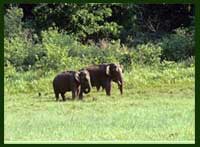
Peppara National Park is the natural habitat of Indian elephant, tiger, panther, mouse deer, Nilgiri langur, sambhar, lion tailed macaque, barking deer, wild boar, etc.
Shenduruni Wildlife Sanctuary:
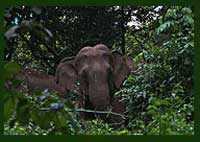
Page 5 of 15
This park has a very rich bio diversity which attracts the touristers and is a heart rending place. The most famous animals in this park are the Indian elephants, One-horned Rhinoceros, Tigers, and Indian Bison, etc. The very exciting amusement here is the Elephant safari tours to view the grasslands and the habitats of the park which are awe-inspiring.
Neyyar Wildlife sanctuary: This Tropical wet evergreen grassland sanctuary is situated at Mullayar, Thiruvanthapuram, in the state of Kerala, a part of South India. It has a wildlife area of about 128 square kilometers. The natural vegetation of Neyyar consists of 39 species of mammals with the natural habitat of elephants, tiger, crocodiles, etc.
Muthanga Wildlife sanctuary:
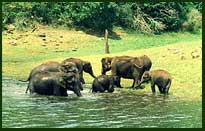
Jim Corbett National Park : The Jim Corbett National Park is located in Ramnagar in the district of Nainital, Uttaranchal, at the foothills of Himalayas. The biggest attraction in this park is the wide variety of wildlife, breathtaking natural vegetation and trekking trails. The usual way to explore the Jim Corbett's park is through the Jeep or Elephant safaris. It is one of the most popular tourist spot. It is the house of 50 species of mammals, variety of faunas and floras. The most common animals are Royal Bengal tiger, Indian elephants, Leopard, Chital, etc.
Bandhavgarh National Park :
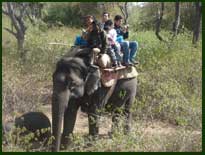
The best way to view all the wildlife of Bandahavgarh National park is by the way of Elephant safari or jeep. But amongst both, Elephant safari is rated as the best way to protect the touristers from other untamed animals.
Page 6 of 15
It has the natural habitat of about 30 species of animals.
It is counted as the finest reserve of Indian Elephants. We could view large herds of elephants in the park and other wildlife attractions of the park include Bengal Tigers, Leopards, Gaurs, Sambar, Chital, Barking Deer, Mouse Deer, Black Napped Hare, Sloth Beer, Wild dog, etc.
Bus and Elephant Safari are the two ways to explore the jungle. Buses are provided for hour long inside the park and offer an excellent view of the exotic wildlife like elephants, tigers, deer etc. Elephant safaris are provided rarely on a day and lasts for half an hour, which is also the best transport to explore the jungle.
Nagarhole National Park:
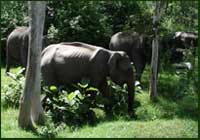
The other national parks where the Indian elephants can be seen in herds are Nameri National Park, Singalilla National Park, Dibru-Saikhowa National Park, Kanha National park, Gorumara National Park, Jaldapara National Park, Idduki Wildlife sanctuary, Kadalundi Bird Sanctuary, Chinnar Wildlife sanctuary, Parambikulam Wildlife sanctuary, Eravikulam National Park, Aralam Wildlife Sanctuary, Silent Valley National Park, Palamau Tiger Reserve (Bihar) and Manas Wildlife Sanctuary. We can also spot elephants in other parks and sanctuary but in few numbers.
Food Habits
Indian elephants are termed as Herbivorous creatures feeding on large amount of floral vegetation. They show much interest in various food variety such as grass, leaves, fruits, barks, roots, bamboo, berries, mangoes, shrubs, tree foliage, apples, coconuts and small stems. Some other favored foods are the cultivated crops like bananas, rice and sugarcane.They spend more than two thirds of the day or in other words up to 20 hours a day for eating the food. They require food of about 330 and 350 pounds every day to eat since half of the food is used by their body. They require water of about 22 to 30 gallons per day. They have a simple digestive system with an odd cylindrical shaped stomach which stores the food for a while and waits for the bacteria to ferment it in the caecum. The total length of the small and large intestines is about 100 feet and it takes a day to digest the meal.
Page 7 of 15
If left free in the cultivated area or open grasslands the elephants can be seen playing like a child.
In zoos, the Indian elephants are tamed and are fed with more healthy food; consisting of 120 - 150 pounds of hay, grasses, cereals and its favorite fruits like berries, bananas, apples, etc. Eventually, they do not get the intention to consume as much as they would in the forests.
Sub species of Indian Elephants found in India
Indian elephant is the subspecies of the Asian Elephants (Elephas Maximus), it is reported by IUCN that majority of the Asian elephants are found in India rather than in their native land. The two other subspecies found in India are:Sri Lankan Elephant (Elephas maximus maximus): It is one of three recognized subspecies of the Asian Elephant, and is native to Sri Lanka. Sri Lankan elephants are the largest subspecies reaching a shoulder height ranging from 6.6 feet to 11.5 feet( 2 to 3.5 m), weighing in between 2,000 and 5,500 kg (4,400 and 12,000 lb), and have 19 pairs of ribs. Their skin color is found to be darker than of indicus and of sumatranus with larger and more distinct patches of depigmentation on ears, face, trunk and belly which distinguishes the maximus from the other two subspecies.
The Sumatran Elephant (Elephas maximus sumatranus):
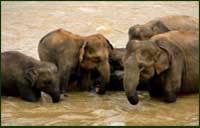
Mating Behaviour
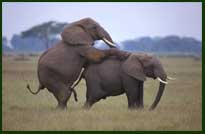
Page 8 of 15
The male genetalia are housed internally. Females are in estrus only 2 to 4 days during their cycle that lasts about 4 months. If conditions are difficult sexual maturity may be delayed several years.
The gestation period is between 630 and 660 days (18-22 months) and then it gives birth to an offspring, occasionally it may give birth to two. The baby elephant is known as calf and usually weighs between 200 and 250 pounds and with a height of 3 feet. When the birth is taking place, the other herd cows or females will form a circle around her, most probably for protection. If the baby is born in a locale where there are large carnivores, the mother will blow dust over the newborn baby in order to dry it and keep the smell of birth from being carried away in the air.
Once after the birth the first thing a calf is made to smell is the dung of the mother which associates her scent to her baby. The calf then suckles from its mother and it could stand at a maximum of two hours. The young are weaned till about 2 years old. Calves have milk tusks that are 2 inches long and they fall off by the time they are 2 years old. Males will then begin to grow permanent tusks .
The young start to stand soon after birth and start to follow their mother in a daily routine for few days. At 4 years, they begin to be independent but under its mother supervision. When the habitat conditions are favorable, female elephants may give birth to a calf every 3 to 4 years, otherwise every 5 to 8 years.
Population of Elephants in India:
India is home for about 50 to 60% of Asian wild elephants and 20% of the domesticated elephants making it possible to survive. Historically and as of now the elephant plays a major role in life of Indians. They are very closely associated with religious and cultural heritage, played an important role in the country's history and remain sacred or holy today.| Wild Elephant Population in India | ||
| Parts of India | Min | Max |
| South | 10,300 | 17,400 |
| Central | 2,400 | 2,700 |
| North-east | 10,300 | 11,300 |
| Other parts | 900 | 1,500 |
| Total | 23,900 | 32,900 |
Page 9 of 15
India is the country where the elephants are used majorly in domestication. Elephants participated in many areas of Indian life right from war and ceremonial use to transport, construction and logging. A survey by Project Elephant has provided the below figures of the Domesticated Elephant population.
| Domesticated Elephant Population in India | ||
| Various people | Min | Max |
| Private Owners | 2,500 | 2,540 |
| Temples | 2,300 | 2,400 |
| Forest Dept | 10,200 | 10,300 |
| Zoos | 800 | 900 |
| Circuses | 100 | 110 |
The domesticated elephants are engaged in various works as mentioned below:
1. Temple Elephants - Many elephants could be found in the temples wherein they are given a permanent home to stay. They enhance the temple status to a great extent by making it a sacred place and attract more people to the temple.
2. Ceremonials and Festivals - Elephants are hired from various private owners during the festival season which may fall between November to May which is the festival season in India for various religious events. Many often the elephants are decorated with various ornaments, precious stones and colored clothes. They would be made to stand the whole day under the hot sun until the festival gets over and would be walking a long way again to attend the next one.
3. Begging street elephants - People use the elephants to exploit the public's admiration for the animals by using them to beg for money on the streets.
4. Tourist elephants - Many elephants could be found in the tourist trade providing rides for the passengers which ranges approximately from 100 to 120. Majority of the elephants are also used for picking up log and other forest work which is reported to be overwork for them and this may led them to a bad health condition.
Page 10 of 15
Threats to Indian elephant and the Conservation effort in India:
The pre-eminent threat to the Indian elephant is the loss of habitat, fragmentation, degradation and the human-elephant conflict when elephants enter into human areas. Indian Elephants have been often hunted for their ivory in order to carve and exhibit various arts and handicrafts. A cross-section of an elephant tusk has a unique pattern of criss-cross lines that combine to form a diamond shaped area which is referred as engine turning. This is one of the reasons for the decline in Elephant population in India.The Indian and other Asian elephant is still a target for poachers today for various reasons like ivory trade, hide and meat, medicinal use and entertainment & other industries. Since the males have been hunted for their tusks, it resulted in destroying the breeding, low birth rates and genetic interchange. In some places we could find only one male for every 100 females. In forest areas, the females as well as males are also killed for their hides and meat which is a threat for their long term survival. India has the largest population of Asian elephants which is estimated as 28,250 but numbers have been reducing due to habitat fragmentation, human encroachment, mining and dam construction. In India, elephant-human conflict results in about death numbers of 300 humans and 200 elephants each year in various ways like poaching, crop protection and any number of other accidents, including vehicle-elephant collisions,etc.

As pert the IUCN, the Indian elephants are classified the 'Endangered Species'(EN), which are those in the danger of extinction and need to be protected by the Endangered Species Act. The various causes of a species of animal becoming endangered are due to Habitat Destruction, Introduction of Exotic Species, Disease, Pollution, and Over exploitation.
Page 11 of 15
a centrally sponsored scheme called 'Project Elephant' (PE)– was launched by the Government of India in the year 1992 with following aim:
- To protect elephants, their habitat & corridors
- To address issues of human-elephant conflict
- To consider the Welfare of domesticated elephants
With reference to the scheme the Indian government has provided financial and technical supports to the various states in the country which has major elephant population. The various states where Project Elephant has been implemented are Andhra pradesh , Arunachal Pradesh , Assam , Jharkhand , Karnataka , Kerala , Meghalaya , Nagaland , Orissa , Tamil Nadu , Uttaranchal , Uttar Pradesh and West Bengal.
Main activities taken under the project are:
-
Ecological restoration (process of recovering the ecosystem that has been degraded, damaged or destroyed) of existing natural habitats and migratory routes of elephants;
- Development of scientific and planned management for conservation of elephant habitats and viable population or normal growth and development of Wild Asiatic elephants in India;
- Promotion of measures for mitigation of human-elephant conflict in crucial habitats and moderating pressures of human and domestic stock activities in crucial elephant habitats;
- Strengthening of measures for protection of Wild elephants from poachers and other unnatural causes of death;
- Research on Elephant management related issues;
- Public education and awareness programmes about elephant to the human;
- Eco-development in various forests
- Veterinary care for elephants
Various MIKE sites in India:
Page 12 of 15
1. Chirang Ripu (Assam)
2. Dhang Patki (Assam)
3. Eastern Dooars (WB)
4. Deomali (Arunachal Pradesh)
5. Garo Hills (Meghalaya)
6. Mayurbhanj (Orissa)
7. Mysore (Karnataka)
8. Nilgiri (Tamil Nadu)
9. Shivalik (Uttarakhand)
10.Wayanad (Kerala)
| PROTECTED AREAS WITH ELEPHANTS | ||
|---|---|---|
| State/ U.T. | No. of P.As. | Area (Sq.Km.) |
| Andaman | 1 | 131 |
| Andhra | 1 | 357 |
| Arunachal | 5 | 3281 |
| Assam | 6 | 1987 |
| Jharkhand | 2 | 960 |
| Karnataka | 9 | 4218 |
| Kerala | 11 | 2158 |
| Meghalaya | 3 | 254 |
| Nagaland | 1 | 56 |
| Orissa | 10 | 4579 |
| Tamil Nadu | 5 | 2489 |
| Tripura | 1 | 349 |
| Uttaranchal | 3 | 2221 |
| Uttar Pradesh | 1 | 490 |
| West Bengal | 5 | 1050 |
| Total | 64 | 24580 |
Mythology :
Page 13 of 15
One of the incident explained in Indian mythology was during "Sagar Manthan" the Gods [Deva] and the demons [Asura] churned the ocean for the "Amrit", the elixir of life which make them eternal or immortal, the 'navratnas' [nine jewels] surfaced out of the ocean and one of these jewels was the 'Elephant'.
Since that time the Elephant is considered extremely precious to be conserved and secluded like the way jewels are protected.
The other mythological story depicts that, Lord Buddha's mother had dreamt of a white elephant in her dreams and soon after that she gave birth to the prophet or clairvoyant of peace - Gautama Buddha. Obviously, this was one of the reasons a white elephant in Indian culture context can never mean redundancy, as it would be in the West.
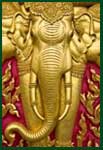
In the middle of the great battle 'Kurukshetra' which was fought between the Pandavas and the Kauravas an innocent lie was announced that Ashvatthama was dead. It deliberately upset the Kauravas by the thought that the teacher's son was dead but in fact, it was the elephant that was killed.
The fact in the Hindu mythology is about the Lord Ganesha, an elephant-headed Hindu divinity. Ganesha has been symbolized with the head of an elephant since the early stages of his appearance in Indian art. Puranic myths provide many justification for how he got the elephant head. One of his well-liked forms, Heramba-Ganapati, has five elephant heads, and other less-common variants in the number of heads can be seen.
Elephant as a symbol in various religions:
In general, the elephant is believed as a symbol of strength, honor, stability, intelligence and patience. Western cultures symbolize the elephant as a symbol of Reliability, Dignity, Power, Royalty and Pride. Chinese symbol of the elephant pertains to happiness, longevity and good luck.Page 14 of 15

strong symbol of luck and they believe that keeping elephant photo-frames or idols at the door of their house would guard them from evil and provide them good luck. Christians symbolize the elephant as an icon of temperance (self-control), patience (bearing annoyances), and chastity (clean/pure).
Elephants in Various Monuments:
Elephants in Various Monuments:1. Elephanta Caves: They are sculpted caves located on Elephanta Island, or Gharapuri (literally "the city of caves") in Mumbai Harbor, in the state of Maharashtra, India. Initially, Elephanta was ruled by the Chalukyan dynasty, and later by Gujarat Sultanate, who surrendered it to the Portuguese in 1534. After that, Elephanta was named as Gharapuri, which denotes a hill in the local Marathi language. The Portuguese then called the island as "Elephanta Island" in honor of a huge rock-cut black stone statue of an elephant that was then installed on a mound, a short distance east of Gharapuri village.
Although there are seven caves, the most important of them is the Mahesamurti cave. There are sculptured compartments in Elephanta caves with awe-inspiring images of Ardhanarisvara, Kalyana-Sundara Siva, Ravana lifting Kailasa, Andhakari-murti (slaying of Andhaka demon) and Nataraja Siva.
2. Elephant stables at Hampi Hampi is a village located at northern Karnataka state, India within the ruins of Vijayanagara which is pointed as an important religious centre. Hampi covers an area of nearly 26 sq km and it is the place depicting the Vijayanagara architecture.
The Mantapas are built on square or polygonal shaped block or slab on which a pedestal, column, or statue is placed with a plain or decorated horizontal part of an entablature between the architrave and cornice that are four to five feet high and have ornate stepped entrances on all four sides with miniature elephants or with Yali balustrades (parapets). The other awe-inspiring monument with the courtly view is the 'Elephant stables' which depicts the innovation of Vijayanagara architects.
Interesting Facts:
Page 15 of 15
◊ The maximum life time of an Indian Elephant is seventy years.
◊ The elephant is the only mammal that can't leap or jump.
◊ An elephant's trunk, with the union of the nose and upper lip, is a highly sensitive organ with over 100,000 muscle units.
◊ Elephants normally walk at the speed rate of 4 mph.
◊ Elephants can swim for long distances.
◊ Elephants spend about 16-22 hours a day eating.
◊ They live in tight social units led by an older matriarch.
◊ Males leave the herd during the ages of 12 and 15.
◊ Their tusks which are called ivory and are actually enormously enlarged incisors.
◊ The Indian Elephant's eyes are small and its eyesight is poor.
◊ Elephants have the largest brains in the animal kingdom.
◊ Indian elephants have one of the softest parts in their body which is at the back of the ears, and is termed as "The knuckle". Usually Mahouts, the Elephant trainers, give commands to the animal via the knuckle at the back of the ears.


